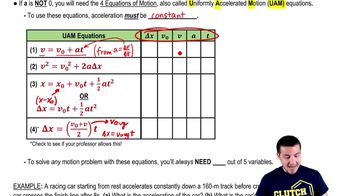Here are the essential concepts you must grasp in order to answer the question correctly.
Newton's Second Law of Motion
Newton's Second Law states that the acceleration of an object is directly proportional to the net force acting on it and inversely proportional to its mass. This principle is crucial for analyzing the motion of the rocket, as the thrust force must overcome both the gravitational force and any inertial resistance to produce acceleration.
Recommended video:
Intro to Forces & Newton's Second Law
Kinematics of Motion
Kinematics involves the study of motion without considering the forces that cause it. In this context, we can use kinematic equations to relate the rocket's initial speed, acceleration, and displacement (height h) to find its final speed. This is essential for determining how the rocket's speed changes as it ascends.
Recommended video:
Conservation of Energy
The principle of conservation of energy states that energy cannot be created or destroyed, only transformed from one form to another. In the case of the rocket, the work done by the thrust force converts chemical energy into kinetic energy and gravitational potential energy as the rocket ascends, allowing us to derive relationships between speed, height, and energy.
Recommended video:
Conservation Of Mechanical Energy



